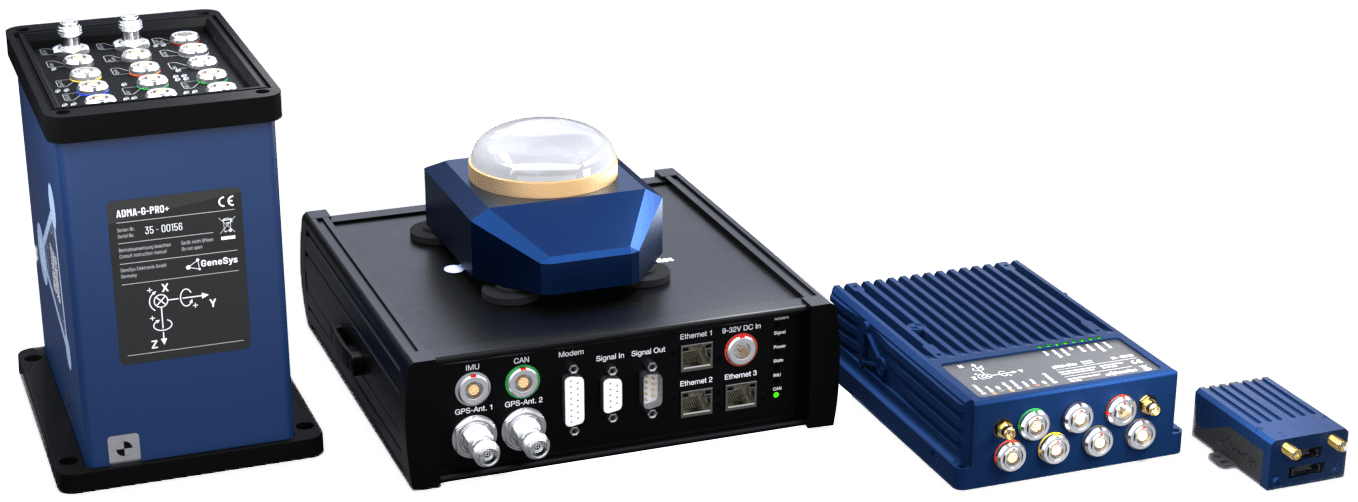Technical Background of gPTP and PTP
Introduction
The Add-On gPTP enables you to synchronize different systems in your network with the ADMA as grandmaster with its GNSS time information.

PTP (Precision Time Protocol) is a protocol, that makes it possible to synchronize network clients on a so called „Grandmaster“ clock precisely.
gPTP (IEEE 802.1AS-2011) is a profile of PTP (IEEE 1588), which always works in P2P (peer-to-peer) mode, while PTP uses E2E (end-to-end). On this basis, gPTP enables more precise time measurement as it measures the delay times directly between neighboring nodes. As a result, however, special network switches are required, as these must be able to synchronize themselves and then determine the delay on the output side with a high degree of accuracy.
Note: Due to the technical background, special switches are required when using gPTP with the ADMA as master (Relay instances time-aware end stations and time-aware bridges).
Explanation of terms
Grandmaster
The Grandmaster is the primary time reference device in the PTP network. It is the device that represents the most accurate time source and provides the reference time for the entire network. There is normally only one grandmaster in the network.
Ordinary Clock
An Ordinary Clock is a device in the PTP network that receives the time from a grandmaster and synchronizes its own clock based on it. It essentially corresponds to a „slave“ in other protocols, but receives the time from the grandmaster instead of generating it.
Clock Domain
In a PTP network, there is usually a grandmaster clock that serves as a reference and other devices or nodes that are oriented to this grandmaster. Each group of devices that are oriented to the same master clock forms a clock domain.
Time Epochs
In the following, the different time epochs get explained. For furher information relating the conversions between the epochs, refer to this Wikipedia article.
GPS Time
GPS time is an artificial time used by Global Navigation Satellite Systems (GNSS) such as the Global Positioning System (GPS). It is based on the number of seconds since January 6, 1980 at midnight (UTC). Unlike UTC, GPS time is not corrected for leap seconds and is therefore continuous (counts up constantly). The GPS time shift (GPS offset) is currently (02/2024) around +18 seconds (due to the leap second differences).
GPS Time = Reference for further conversionsUTC Time (Coordinated Universial Time)
UTC is an international time standard that serves as a reference for measuring time worldwide. It is based on the number of seconds since midnight on January 6, 1980. The UTC time is corrected by the number of current leap seconds and is therefore a variable time scale. It is often referred to as „Zulu time“ (Z) in aviation and military applications.
UTC Time = GPS Time - LeapsecondsPTP Time
The PTP time is corrected by the leap seconds and starts on January 1, 1970.
PTP Time = GPS Time + 315964800 sec - LeapsecondsUNIX Time
UNIX time, also known as POSIX time or epoch time, is a form of time measurement that is widely used in computer science. It counts the seconds that have elapsed since January 1, 1970 at 00:00:00 UTC (a date known as the „Unix epoch“), without taking leap seconds into account. UNIX time is normally represented as an integer indicating how many seconds have elapsed since this start time.
UNIX Time = GPS Time + 315964800 secNote: 315964800 seconds is the offset between the two points in time at which counting began in the different time systems.
Configuration Parameters
| Parameter | Description |
|---|---|
| Roleㅤㅤㅤㅤㅤㅤㅤㅤㅤㅤㅤㅤㅤㅤ | In the first release of the Add-On it is only possible to use the ADMA as grandmaster. |
| Delay mechanismㅤㅤㅤㅤㅤㅤㅤㅤㅤㅤㅤㅤㅤㅤㅤㅤㅤ | The gPTP standard uses the P2P technique.ㅤㅤㅤㅤㅤㅤㅤㅤㅤㅤㅤㅤㅤㅤㅤㅤㅤㅤㅤㅤㅤㅤㅤㅤㅤㅤㅤㅤㅤㅤㅤㅤㅤㅤㅤㅤㅤㅤㅤㅤㅤㅤㅤㅤㅤㅤㅤㅤㅤㅤㅤㅤㅤㅤ |
| Modeㅤㅤㅤㅤㅤㅤㅤㅤㅤㅤㅤㅤㅤㅤㅤㅤㅤㅤㅤㅤㅤㅤㅤ | 2-Step: The Grandmaster informs the ordinary clock about an upcoming synchronization and in the second step, the delay is determined and provided. |
| Clock domain | Defines the created clock domain. |
| Time epoch | Defines the used time base. |
| Time offset | Enables user defined time offsets. |




